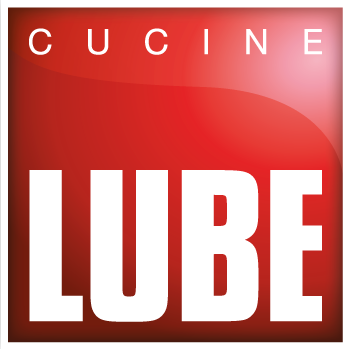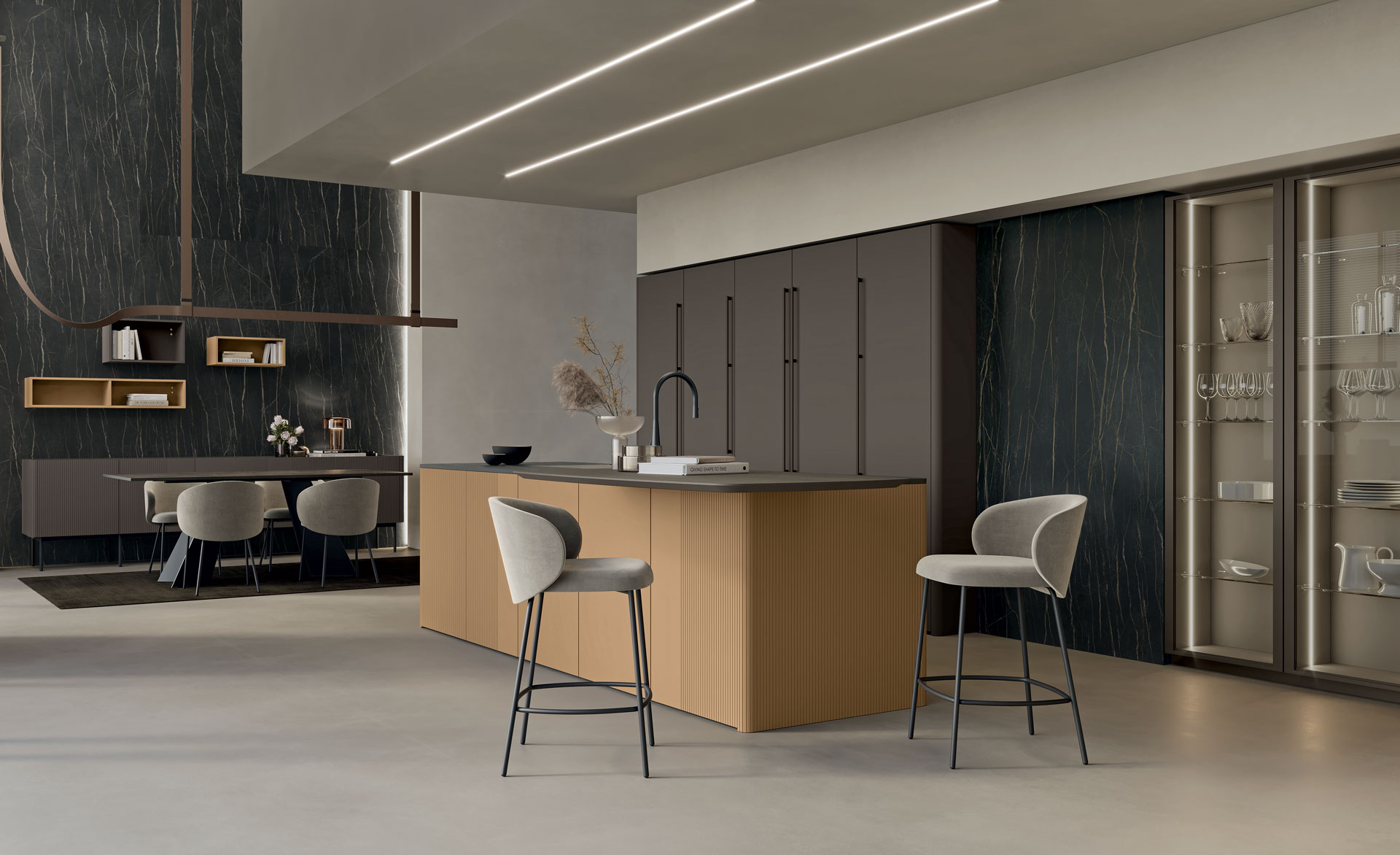

LUBE INDUSTRIES Srl Via dell’industria, 4 - Treia (MC) - Italy
SHADE Lab kitchen furniture model.

This product sheet complies with the provisions of Legislative Decree No. 206 of September 6, 2005 "Consumer Code".
22 mm thick door made of an MDF wood fiber panel (compliant with US EPA TSCA Title VI) lacquered in matte or brushed gloss.
Applied frontally to the door, horizontal or vertical.
22 mm thick door made of an MDF wood fiber panel (compliant with US EPA TSCA Title VI) melamine-coated on both sides, edged and super matte lacquered with excimer technology. The back is lacquered in matching color with a 10 gloss micro-textured finish with a slightly embossed surface.
*The new super matte excimer finish allows for lacquered panels with 0 gloss while maintaining high technical characteristics: total opacity, anti-reflection, anti-fingerprint, and scratch resistance.
Applied frontally to the door, horizontal or vertical.
22 mm thick door made of an MDF wood fiber panel (compliant with US EPA TSCA Title VI) lacquered with a pearlescent effect.
The finish combines the elegance of matte with a touch of sophisticated brightness. The extra matte paint, enriched with pearl microspheres, creates a pearlescent effect that gently reveals itself in the light and feels velvety to the touch.
Pearlescent effect surfaces require careful attention, especially during the product cleaning phase. It is recommended to use mild detergents that do not damage or compromise the painted surface finish.
Applied frontally to the door, horizontal or vertical.
22 mm thick door made of an MDF wood fiber panel (compliant with US EPA TSCA Title VI) with a textured lacquered finish.
The finish is designed to replicate the scratched steel sheet in a light-dark color tone.
The scratch is shallow and smooth to the touch. The black satin finish moves horizontally and vertically. After the drying phase, the product is antiqued with a specific product manually worked to ensure the streaked effect on the surface and edge of the panel.
Textured surfaces require careful attention, especially during the product cleaning phase. It is recommended to use mild detergents that do not damage or compromise the painted finish.
Applied frontally to the door, horizontal or vertical.
22 mm thick door made of an MDF wood fiber panel (compliant with US EPA TSCA Title VI) lacquered with a vintage metal effect finish.
The finish is created thanks to an initial phase of base application, on which the varnish with the VINTAGE effect is subsequently applied. After an initial drying, the door undergoes a series of manual surface processes, through which the aged metal sheet effect is obtained.
The surface does not show evident scratches, ensuring a linear product without pronounced markings.
Metal effect surfaces require careful attention, especially during the product cleaning phase. It is recommended to use mild detergents that do not damage or compromise the painted finish surface.
Applied to the front of the door, horizontal or vertical.
22 mm thick door made of an MDF wood fiber panel (compliant with US EPA TSCA Title VI) with a semi-gloss vintage brushed effect lacquered finish.
The finish is designed to replicate the metallic satin finish typical of stainless steel sheets through small mechanically applied scratches that allow the surface to have a blur and reflect at the same time in the same direction as the satin finish.
Brushed effect surfaces require careful care, especially during the product cleaning phase. It is recommended to use mild detergents that do not damage or compromise the painted finish surface.
Applied frontally to the door, horizontal or vertical.
22 mm thick door made of an MDF wood fiber panel (compliant with US EPA TSCA Title VI) lacquered with oxidized liquid metal.
The finish is created through an initial phase of base application, on which the paint is subsequently applied, followed by a series of manual surface processes that give the effect of oxidized sheet metal.
This type of effect is enhanced by the black circular spots (more pronounced compared to the VINTAGE METAL EFFECT finish) in random and uneven surfaces, as evidence of a manual aesthetic process accentuated over the entire surface of the panel.
The edges are scratched in a circular manner stained by the decorator, trying to ensure a continuous surface even on the side of the panel.
Metal effect surfaces require careful attention, especially during the product cleaning phase. It is recommended to use mild detergents that do not damage or compromise the painted finish surface.
Applied frontally to the door, horizontal or vertical.
The finishes of the SHADE LAB model identified as Special Lacquer (PEARLESCENT EFFECT – TEXTURE EFFECT – VINTAGE METAL EFFECT – VINTAGE BRUSHED EFFECT – OXIDIZED LIQUID METAL) represent the result of a handcrafted process, performed manually by specialized decorators. After an initial painting phase, specific treatments are applied to create a unique and valuable effect. Depending on the chosen finish, the processing phase can blend or expand the texture of the paint on the flat surface or edges. The more or less evident surface effects are therefore an intrinsic characteristic of the product, effectively making each piece unique and exclusive.
The presence of any discolorations (e.g., spots, light/dark areas, scratches, and irregularities of various kinds, etc.) should not be considered a defect, but rather the guarantee of a handmade product. Similarly, color variations, especially following the addition of new elements to an existing kitchen or any replacements, are among the natural aspects of the product*.
Therefore, these peculiarities cannot be a reason for complaint.
* In case of defects along the edges of the doors (small chips or paint defects), it is preferable to consider, if possible, repairing the defect rather than replacing the element.
Consisting of 18 mm thick melamine-faced chipboard panels in accordance with the US EPA TSCA Title VI standard (with very low formaldehyde emission).The shelves are 18 mm thick and equipped with built-in shelf supports with locking device. They can also be made of tempered glass (6 mm thick), grounded on the edges.
Edge in ABS or Polypropylene (PP) glued with thermosetting polyurethane glues 1 mm thick on the front parts of the unit sides and shelves and 0.5 mm thick on the lower and upper parts of the unit sides and on the sides and rear part of the internal shelves. Made of paper for the non-visible parts of furniture (back).
Consisting of 2.8 mm thick high-density fibre panels compliant with E1 and US EPA TSCA Title VI for formaldehyde emissions, wall units with polypropylene veneers and painted bases and columns.
Laminate worktop: 38 or 58 mm thick water-repellent wood particle board coated with high pressure laminate (HPL). For worktops in other materials, please refer to the "Useful information" section.
In sheet 18/10 stainless steel made using a single-casting or electrically welded tubs, with a smooth or "embossed" finish. For sinks in other materials, please refer to the "Useful information" section.
Faced bracket: melamine faced wood particle board panel (class E1); ABS edging.Veneered bracket: wood particle board panel (class E1) veneered with "slices" of wood (which vary depending on the model) and lacquered using acrylic/polyurethane products.
In pine wood or MDF (class E1) veneered with "slices" of wood (which vary depending on the model); acrylic/polyurethane lacquering.
In chequered aluminium or lacquered plastic to protect the sink unit from water seepage.
In knock-resistant plastic material (PVC) and height-adjustable, these are screwed to the bottom of the cabinet using special bushing, without requiring any drilling in the lower part of the casing (thus completely avoiding the creation of areas in which dirt may accumulate or through which water could leak into the base and sink cabinets).They are also available in aluminium and can be adjusted and mounted on a special base structure (also made using an aluminium profile).
These elements may be made using anodised or lacquered aluminium, or PVC coated with decorative melamine foil, and have a rubber seal at the top and bottom.
In rigid plastic material (PVC), drilled in the centre to allow any leaking water to escape and to protect the main cabinet column.
In aluminium or rigid knock-resistant PVC with laminate decoration.
In sheet steel and zamak alloy, copper-plated and nickel-plated for resistance to corrosion; adjustable in three directions.
The structure may consist of a 16 mm thick wood particle base (extremely low formaldehyde emission) faced in grey laminate with side and back panels in galvanised and lacquered sheet steel for protection against corrosion. Alternatively the structure can be made entirely of solid ash and plywood; sliding takes place by means of total extraction runners with a grooved system for anti-detachment locking and automatic closure which is activated in the final 4 cm. The soft-close system (blu-motion) is also supplied as standard.
In electrically welded metal wire; they may be plasticised with polymer resin, nickel-plated or chrome-plated and coated with a transparent plastic sheath (Crominox finish).
Top: may be a wood particle panel (class E1) coated with HPL plastic laminate (see laminate worktop) or veneered with "slices" of wood and lacquered with water-based, polyurethane or acrylic shades, or it may be made using glass, granite or natural stone.Borders and base structure: these may be made using metal or plywood panels, faced or veneered with "slices" of wood (these vary depending on the model).Legs: these may be made using metal or solid wood; lacquering is carried out using acrylic/polyurethane products.
Structure: this may be in tubular metal lacquered with thermosetting powders, or in solid wood lacquered using water-based (impregnating) and acrylic/polyurethane products (base).Seat and Backrest: these may be made using synthetic material (methacrylate), solid wood, plywood, upholstered fabric or simulated wicker.
Note: each type of chair or table is identified at the site of purchase by the relevant adhesive label on the packaging.For further information, please check the user and maintenance manual provided by GRUPPO LUBE.
For further information, please check the user and maintenance manual provided by GRUPPO LUBE.